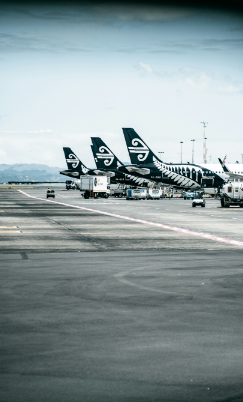Understanding Air New Zealand Turbulence: Causes, Impacts, and Safety Measures
Air New Zealand Turbulence
Turbulence is an often-discussed aspect of air travel that can cause discomfort and concern among passengers. Essentially, turbulence refers to irregular or unpredictable air movements that can cause an aircraft to experience sudden, sometimes violent, changes in altitude and direction. These air disturbances can be caused by a variety of factors, including atmospheric pressure, jet streams, mountain waves, and thunderstorms. For airlines like Air New Zealand, which operates extensive routes across the Pacific and within New Zealand’s diverse topography, understanding and managing turbulence is crucial.
Air New Zealand flights frequently encounter turbulence due to the unique geographical and meteorological conditions prevalent in the regions they cover. The airline’s routes often traverse areas with significant weather activities, such as the Southern Hemisphere’s roaring forties and the tropical cyclone-prone South Pacific. These conditions make it imperative for Air New Zealand to continually monitor weather patterns and adjust flight paths to mitigate turbulence impacts.
The significance of understanding turbulence extends beyond passenger comfort; it is also vital for the safety and operational efficiency of flights. Pilots and airline staff must be well-versed in identifying and responding to different types of turbulence to ensure a smooth flight experience. For example, clear-air turbulence, which is particularly challenging to predict, requires advanced detection systems and real-time communication between aircraft and ground control.
For passengers, knowledge about turbulence can alleviate anxiety and enhance the travel experience. Awareness of the airline’s proactive measures, such as advanced weather forecasting and pilot training, can reassure passengers that their safety is the top priority. As we delve deeper into the causes, impacts, and safety measures related to turbulence on Air New Zealand flights, it becomes clear that understanding this phenomenon is essential for both airline operations and passenger peace of mind.
Causes of Turbulence in Air New Zealand Flights
Turbulence is a common occurrence in aviation, and Air New Zealand flights are no exception. Understanding the causes of turbulence helps in comprehending the complexities faced during flights. There are several types of turbulence, each with distinct characteristics and causes. Clear-air turbulence, for instance, is often encountered at high altitudes and is not associated with visible weather phenomena, making it challenging to detect and avoid. This type of turbulence typically occurs due to jet streams and the varying wind speeds in the upper atmosphere.
Mechanical turbulence, on the other hand, is caused by obstacles such as mountains or buildings that disrupt the airflow. For Air New Zealand, the Southern Alps play a significant role in generating mechanical turbulence. As the wind flows over these mountain ranges, it can create turbulent air currents which pilots need to navigate carefully. This is particularly prevalent when flights traverse the South Island, where the Southern Alps are located.
Convective turbulence is another form that is primarily driven by thermal activity. This type of turbulence occurs when warm air rises and cool air descends, creating unstable air currents. In New Zealand, the varied topography and maritime climate contribute to frequent convective activity, especially over the Tasman Sea. The interaction between the sea and the landmass, combined with the prevailing westerly winds, can create significant convective turbulence, particularly during the summer months when thermal activity is at its peak.
New Zealand’s unique geographic and meteorological conditions significantly influence the turbulence experienced by Air New Zealand flights. The combination of the Southern Alps, the expansive Tasman Sea, and the consistently strong westerly winds all contribute to a dynamic flying environment. Pilots are trained to anticipate and manage these conditions, ensuring passenger safety remains the top priority despite the turbulent nature of the region’s airspace.
Impact of Turbulence on Flight Operations
Turbulence presents a significant challenge to Air New Zealand’s flight operations, impacting various aspects such as flight schedules, fuel consumption, and aircraft maintenance. One of the primary operational challenges is the potential for flight delays and rerouting. When turbulence is forecasted along the intended flight path, pilots may need to alter their routes to ensure passenger safety. This can result in extended flight times, leading to disrupted schedules and missed connections.
Moreover, turbulence affects fuel consumption. Deviating from the planned route or maintaining different altitudes to avoid turbulent zones can lead to increased fuel usage. Consequently, this elevates operational costs, as fuel is a major expense for airlines. Additionally, the wear and tear on aircraft caused by frequent encounters with turbulence necessitates more rigorous maintenance checks and potential repairs, further driving up operational costs.
The workload of pilots and cabin crew is also significantly impacted by turbulence. Pilots must constantly monitor weather reports and adjust flight plans accordingly, which can be mentally taxing. They also have to communicate effectively with air traffic control and keep passengers informed, adding to their responsibilities. Cabin crew, on the other hand, must ensure passenger safety during turbulent periods, often requiring them to secure the cabin and manage any passenger concerns or injuries that may arise.
To manage these challenges, Air New Zealand employs several measures. Advanced weather forecasting systems and turbulence detection technologies are used to predict and avoid turbulent areas. Crew members undergo rigorous training to handle turbulent conditions and maintain composure under pressure. Moreover, clear protocols are in place to minimize the impact on flight operations, such as predefined alternate routes and efficient communication channels between pilots, air traffic control, and ground operations.
Overall, while turbulence poses substantial operational challenges, Air New Zealand’s strategic measures and technological advancements help mitigate these impacts, ensuring safe and efficient flight operations.
Passenger Experience During Turbulence
Turbulence is a common occurrence on Air New Zealand flights, and its impact on passengers can vary significantly. While some passengers may experience mild discomfort, others might face severe anxiety. The unpredictable nature of turbulence often exacerbates these reactions, leading to a wide range of emotional and physical responses.
For many passengers, the initial experience of turbulence triggers a sense of unease. The sudden jolts and dips can cause feelings of nervousness and apprehension. Passengers often describe a heightened sense of vulnerability, especially when the turbulence is prolonged or particularly intense. Common physical reactions include muscle tension, increased heart rate, and even nausea.
Air New Zealand has implemented several measures to mitigate these reactions and ensure passenger safety and comfort. The airline’s crew is trained to handle turbulence with professionalism and composure, providing clear and reassuring communication throughout the experience. Passengers are informed about the expected duration and intensity of turbulence, which can alleviate some of the anxiety associated with the unknown.
Moreover, Air New Zealand pilots make regular announcements to keep passengers updated on weather conditions and flight status. These updates are crucial in maintaining a sense of control and reassurance among passengers. By explaining the nature of turbulence and its impact on the flight, the crew helps demystify the experience and reduce fear.
Passengers have shared various testimonials about their experiences with turbulence on Air New Zealand flights. One traveler recounted a particularly turbulent flight where the crew’s constant communication and calm demeanor made a significant difference. “I was extremely anxious,” they noted, “but the pilot’s updates and the flight attendants’ reassurances helped me stay calm.”
Another passenger highlighted the importance of preparation, mentioning that the airline’s safety briefings and turbulence protocols provided a sense of security. “Knowing that the crew was well-prepared and that there were clear procedures in place gave me confidence,” they said.
Overall, while turbulence can be challenging for passengers, Air New Zealand’s commitment to clear communication and effective safety measures plays a crucial role in enhancing the overall travel experience during such events.
Safety Measures and Protocols
Air New Zealand prioritizes passenger safety by implementing comprehensive measures and protocols to manage turbulence effectively. Central to their approach is the utilization of advanced weather forecasting and turbulence detection systems. These technologies allow for proactive identification of potential turbulent zones, enabling pilots to make informed decisions about flight paths and altitudes, thus minimizing discomfort and risk.
Real-time data monitoring plays a critical role in ensuring a smooth flight experience. Air New Zealand continuously tracks weather conditions and turbulence reports from multiple sources, including satellite data and reports from other aircraft. This real-time information helps pilots adjust their route dynamically to avoid severe turbulence whenever possible.
In addition to technological advancements, extensive training is provided to both pilots and cabin crew. Pilots undergo rigorous simulation training that prepares them for various turbulence scenarios, ensuring they can handle unexpected situations with confidence and expertise. Cabin crew members are trained to manage turbulence-related issues, ensuring passenger safety and comfort through clear communication and effective response strategies.
Passenger adherence to safety instructions is equally important in managing turbulence. Air New Zealand emphasizes the importance of keeping seat belts fastened while seated, as this simple measure significantly reduces the risk of injuries during unexpected turbulence. The airline also provides clear and concise safety briefings before each flight, ensuring passengers are well-informed about safety protocols and emergency procedures.
Overall, Air New Zealand’s commitment to safety through advanced technology, comprehensive training, and clear communication ensures that passengers can travel with confidence, even in the face of turbulence. By fostering a culture of safety and preparedness, the airline effectively mitigates the impacts of turbulence, prioritizing the well-being of all on board.
Technological Innovations in Turbulence Management
Air New Zealand has embraced a range of technological advancements to predict and manage turbulence, significantly enhancing passenger safety and comfort. One of the primary innovations is the use of advanced predictive software that forecasts turbulence with high accuracy. By analyzing weather patterns, wind speed, and atmospheric conditions, this software allows pilots to anticipate turbulence well in advance and adjust flight paths accordingly. This predictive capability not only helps in avoiding turbulent areas but also in planning smoother and more efficient routes.
Additionally, turbulence mapping tools have become crucial in real-time turbulence management. These tools provide live data on turbulence intensity and location, enabling pilots to make informed decisions during flights. For instance, the use of LIDAR (Light Detection and Ranging) technology helps in detecting clear-air turbulence, which is otherwise invisible and can cause unexpected disturbances. By integrating these tools into the cockpit, Air New Zealand ensures that pilots have the most up-to-date information to navigate turbulent skies safely.
Improved aircraft design also plays a vital role in mitigating the effects of turbulence. Modern aircraft are engineered with advanced materials and aerodynamics to withstand and minimize the impact of turbulent airflows. Features such as flexible wings and enhanced stabilization systems contribute to a smoother flying experience. Air New Zealand’s fleet incorporates these design advancements, reflecting the airline’s commitment to safety and passenger comfort.
These technological innovations are seamlessly integrated into daily flight operations. The collaboration between predictive software, turbulence mapping tools, and improved aircraft design creates a comprehensive approach to turbulence management. Pilots receive continuous training on utilizing these technologies effectively, ensuring that they are well-prepared to handle turbulence. Consequently, passengers can enjoy a safer and more comfortable journey, as Air New Zealand leverages cutting-edge technology to navigate the complexities of modern air travel.
Case Studies of Notable Turbulence Incidents
Air New Zealand, like all airlines, has encountered various turbulence incidents throughout its history. Analyzing these events provides valuable insights into the causes, responses, and safety measures involved.
One significant incident occurred in July 2015 on Air New Zealand flight NZ90 from Tokyo to Auckland. The aircraft encountered severe turbulence over the Pacific Ocean, resulting in injuries to several passengers and crew members. The turbulence was unexpected and due to clear air turbulence (CAT), which is difficult to predict. The flight crew responded promptly by securing the cabin and providing medical assistance to those affected. As a result of this incident, Air New Zealand emphasized the importance of keeping seatbelts fastened at all times and enhanced its communication protocols regarding turbulence forecasts.
Another notable incident took place in February 2017 on flight NZ8 from Auckland to Honolulu. The aircraft experienced sudden turbulence shortly after takeoff, causing minor injuries to some passengers. Investigations revealed that the turbulence was caused by a jet stream shift, a common occurrence that can lead to abrupt changes in wind patterns. The crew’s immediate response included instructing passengers to remain seated and ensuring that all loose items were secured. Following this event, Air New Zealand improved its pilot training programs to better handle such unexpected weather phenomena.
In June 2019, flight NZ27 from Los Angeles to Auckland faced severe turbulence over the Pacific. Several passengers were injured, and the cabin experienced significant disruption. This incident was attributed to a combination of CAT and mountain wave turbulence, which occurs when air flows over mountain ranges. The flight crew acted swiftly, following established procedures to minimize risks and provide care for the injured. Air New Zealand subsequently updated its turbulence detection technology and implemented more rigorous pre-flight weather briefings.
These case studies highlight the unpredictable nature of turbulence and underscore the importance of effective response strategies. Air New Zealand has continuously adapted its practices and policies to enhance passenger safety and improve its ability to manage turbulence-related incidents. The lessons learned from these events have reinforced the airline’s commitment to maintaining high standards of safety and preparedness.
Future Directions in Turbulence Management
As the aviation industry continues to evolve, Air New Zealand is at the forefront of adopting innovative strategies to manage turbulence more effectively. Ongoing research in atmospheric science and advancements in aviation technology are central to these efforts. One emerging area of focus is the development of more accurate predictive models for turbulence, leveraging advancements in machine learning and big data analytics. These models aim to provide pilots with real-time information about atmospheric conditions, allowing for more informed decision-making and route adjustments to minimize turbulence encounters.
In addition, Air New Zealand is exploring the use of advanced sensor technologies on aircraft to detect turbulence with greater precision. These sensors can measure minute changes in air pressure and movement, providing early warnings to pilots and enabling more proactive management of turbulence. The integration of these sensors with the aircraft’s existing navigation systems ensures that pilots have a comprehensive view of the surrounding atmospheric conditions, enhancing overall flight safety.
Climate change is another critical factor influencing turbulence management. As weather patterns become increasingly unpredictable, Air New Zealand is investing in research to understand how these changes impact turbulence frequency and intensity. Collaborating with meteorological organizations and academic institutions, the airline is working to develop strategies that can predict and mitigate the effects of climate-induced turbulence. This includes refining flight planning processes to account for more dynamic weather scenarios, ensuring that passengers experience smoother and safer flights.
Furthermore, Air New Zealand is committed to continuous improvement in passenger comfort. The airline is evaluating the potential of next-generation aircraft designs that offer enhanced stability and reduced susceptibility to turbulence. These designs, coupled with state-of-the-art cabin features, aim to provide a more comfortable flying experience, even in the presence of turbulence.
In summary, the future of turbulence management for Air New Zealand is rooted in cutting-edge research and technological innovation. By staying ahead of developments in atmospheric science and aviation technology, the airline is well-positioned to enhance both the safety and comfort of its passengers, ensuring a superior travel experience even amidst changing global weather patterns.

The PakSoil News Team is a dedicated group of journalists, editors, and analysts committed to delivering accurate, timely, and balanced news coverage. From politics and business to culture and community, we bring you stories that matter — verified, unbiased, and written with integrity.



